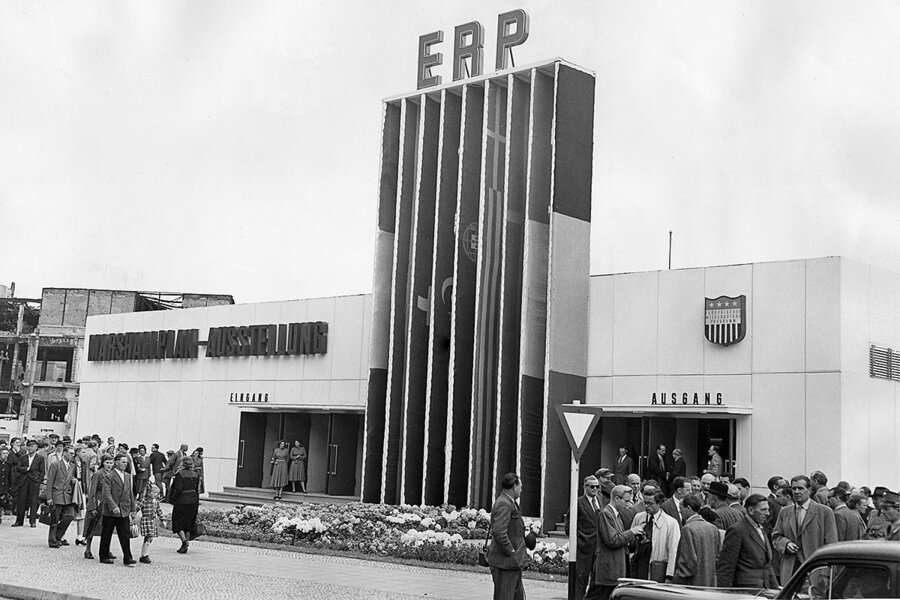US-Europe ties and the audacity of July 1948
Loading...
| London
In July 1948, the Marshall Plan got under way as an audacious bid to reconstruct a shattered Europe. The aim was to keep the USSR from encroaching beyond Eastern Europe, in part by rebuilding Western Europe into a bulwark of democratic, market-economy allies. In July 2018, as President Trump embarks on talks with NATO leaders, Britain, and Russia, the picture looks very different. He arrives in Europe unapologetically at odds with America’s allies, and ready to shake up NATO. It’s too early to say if we are witnessing the beginning of the end of Truman’s postwar diplomatic and security architecture. But Mr. Trump’s view that, on security and trade, the United States would be better off dealing with European countries one-on-one represents a dramatic departure. Winston Churchill described America’s postwar engagement in Europe as “the most unsordid act in history.” Yet its architects said it was in America’s interests as well – opening an increasingly lucrative export market for US businesses and creating a NATO alliance to share security burdens. Former Secretary of State Madeleine Albright, in London recently, pointed to the risk of America “withdrawing completely” and undermining the system of transatlantic alliances. She noted: “Putin’s goal is to separate us from our allies.”
Why We Wrote This
President Trump's go-it-alone approach is familiar in US history. But as he meets leaders of NATO, Britain, and Russia, many question its implications for a postwar order they say benefits Europe and the US alike.
The differences are stark, and so are the potential implications: two weeks in July, separated by exactly 70 years and by diametrically opposite visions of America’s place in the world.
In July 1948, the first of hundreds of shiploads of American goods were docking in Europe under the Marshall Plan. The most audacious such program in history, it would, over four years, send the present-day equivalent of more than $130 billion in US aid to the shattered post-World War ll economies of Western Europe. It rescued not just the victims and eventual victors, like Britain and France. It was critical to the emergence of West Germany as an economically strong, democratic state, and also helped to lay the groundwork for what eventually became the European Union.
Most of all, along with the NATO defense pact a year later, it represented a bold assertion of American leadership of an alliance of European democracies – a defining tenet of US foreign policy, under both Republican and Democratic administrations, ever since.
Why We Wrote This
President Trump's go-it-alone approach is familiar in US history. But as he meets leaders of NATO, Britain, and Russia, many question its implications for a postwar order they say benefits Europe and the US alike.
July 2018 looks very different. Over the next week, President Donald Trump will hold three rounds of summit talks: with NATO leaders, British Prime Minister Theresa May, and Russian President Vladimir Putin. He arrives in Europe unapologetically at odds with America’s post-war allies, having denigrated NATO, opened a potential trade war with the EU, and portrayed the transatlantic partnership as a colossal rip-off of US commercial and financial interests.
It’s too early to say whether we are witnessing the beginning of the end of the postwar diplomatic and security architecture constructed under President Harry Truman. Some of President Trump’s toughest talk toward America’s NATO partners has been aimed at pressuring them to increase their own defense spending, also a goal of previous administrations. But his view that, on both security and trade, the US would be a lot better off dealing with individual European countries on a one-on-one basis represents a dramatic departure.
That’s why US allies in Europe are watching this week’s summitry with such interest. They’re especially uneasy about the Putin meeting, all the more so if it comes on the heels of a fractious NATO summit and a UK visit in which Trump in effect cheerleads for a “hard Brexit” as Prime Minister May seeks support for a softer approach.
Specifically, they’re worried about the prospect of a unilateral move by Trump for a rapprochement with Russia – at the cost of weakening Western sanctions over its aggression in Ukraine and annexation of Crimea; minimizing the threat of pressure on the former Soviet Baltic republics of Latvia, Estonia, and Lithuania; and glossing over Russian cyberattacks and fake-news meddling in European elections.
The reason for looking back at that other week in July – in 1948 – is that it brings home what a historic shift such a go-it-alone tack would represent. It also highlights how historic the post-war US policy on Europe was when it was first put in place.
It was largely the creation of a small core of extraordinarily dedicated and self-confident diplomats: Dean Acheson and Averell Harriman; Moscow experts George Kennan and Charles Bohlen; and wartime colleagues at the War Department, John McCloy and Robert Lovett.
I’ve just been rereading a wonderful, epic tome on how these six colleagues remade US diplomacy – "The Wise Men," by Walter Isaacson and Evan Thomas. I was reminded not only of the complex, postwar world in which they operated, and how profoundly they changed US engagement with the world, but above all how improbable their achievement was.
Trump’s retreat from international engagement is a familiar theme in US history. It could easily have won the day after World War ll – as it did after World War l, when Woodrow Wilson failed to secure domestic support for the forerunner of the UN, the League of Nations.
Truman’s predecessor, Franklin Roosevelt, faced huge opposition to the idea of American troops coming the aid of Britain at the outset of World War ll, even when Hitler had invaded and occupied much of the rest of Europe. It was an argument he won only when Japan attacked Pearl Harbor.
Once the war was over, most Americans were in a mood – in Harriman’s phrase – simply to turn inward, “go to the movies and drink Coke.”
Informing the very different road taken under Truman was one key aim and one key assumption. The aim – articulated in the “containment” policy formulated by Kennan – was to keep Josef Stalin’s USSR from encroaching beyond the East European countries nearest its borders and into Western Europe. The assumption was that rebuilding the economies of the rest of Europe was critical not just to averting political crisis there, but to building a bulwark of democratic, market-economy allies to forestall further Soviet expansion.
Britain’s prime minister, Winston Churchill, described America’s postwar engagement in Europe as “the most unsordid act in history.” Yet it was central to the thinking of its architects that it was in America’s interests as well. In addition to putting Europe back on its feet, the Marshall Plan opened a huge and increasingly lucrative export market for US businesses. US national security also benefited, with an integrated NATO alliance reducing the need for the American military to assume prime, direct responsibility for defense against possible further Soviet expansion westward.
The irony is that the real time for questioning the transatlantic partnership came some 30 years ago, with the collapse of the Soviets’ East European empire and then of the USSR itself. The optimistic view at the time, with Boris Yeltsin at the helm, was that a move to a wider political, economic, and security partnership integrating a post-Soviet Russia might well be possible.
But Putin’s Russia is a different prospect. NATO, which in the 1990s found itself searching for a post-cold war role, now increasingly faces European security challenges not all that different from Soviet times.
Fascinatingly, Kennan was uncomfortable with the degree to which, during the hard slog of getting congressional approval for the Marshall Plan, the Truman administration stressed the threat of Soviet Communist expansionism. He believed the more complex challenge was Russia’s pre-Soviet insecurities about its borders – a view that resonated with me during my own years as the Monitor's correspondent in Moscow in the 1980s. Containment, Kennan argued, was necessary because Russian leaders, whether czarist or Soviet, would try to push outward, but would hold the line if met with a credible check.
With Russian pressure on Ukraine and the Baltic states, and Putin’s evidently irreversible decision to annex Crimea, NATO’s European partners feel the alliance has a role in providing such a check – not just against military action but also newer potential threats such as cyber attacks.
Trump seems intent on shaking up NATO. Former Secretary of State Madeleine Albright, at a recent event in London to promote her latest book, seemed to recognize the need to address that political impulse. “When you’re 70 years old, whether you’re an institution or a person, you need a little refurbishing,” she quipped.
Yet the key, she argued, was to recognize the risk of America “withdrawing completely” and undermining the system of transatlantic alliances, adding: “Putin’s goal is to separate us from our allies.”








